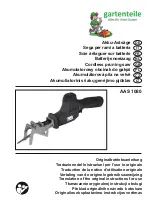
G0513 Series Bandsaws (Mfd. Since 08/22)
-47-
Blade Dimensions
Length Range ................................ 130
1
⁄
2
"–131
1
⁄
2
"
Width Range ..............................................
1
⁄
8
"– 1"
Blade Length
Measured by the blade circumference, blade
lengths are specific to each bandsaw. They are
determined by the wheel diameter and distance
between the wheels. Blades will vary slightly
even in the same length because of how they are
welded. Refer to the
Accessories section later in
this manual for blade replacements from Grizzly.
Blade Width
Measured from the back of the blade to the tip of
the blade tooth (the widest point), blade width is
often the first consideration given to blade selec-
tion. Blade width dictates the largest and smallest
curve that can be cut, as well as how accurately it
can cut a straight line.
•
Curve Cutting: Use the chart in Figure 69
to determine the correct blade for curve cut-
ting. Determine the smallest radius curve that
will be cut on your workpiece and use the
corresponding blade width (refer to
Cutting
Curves on Page 56 for more information).
Blade Width
Cutting Radius
5
1
/
2
"
3
/
4
"
Figure 69. Recommended cutting radius per
blade width.
•
Straight Cutting: Use the largest width
blade that you own. Large blades excel at
cutting straight lines and are less prone to
wander (known as blade lead —refer to
Page
67 for more information on blade lead).
Tooth Style
Figure 70 illustrates the three main blade tooth
styles:
•
Raker: Considered to be the standard
because the tooth size and shape are the
same as the tooth gullet. The teeth on raker
blades usually are very numerous, have no
angle, and produce cuts by scraping the
material. As a result, smooth cuts can be
achieved without cutting fast or generating
more heat than other tooth types.
•
Skip: Similar to a raker blade that is missing
every other tooth. Because of the design,
skip toothed blades have a much larger gullet
than raker blades, and therefore, cut faster
and generate less heat. However, these
blades also leave a rougher cut than raker
blades.
•
Hook: The teeth have a positive angle
(downward) which makes them dig into the
material, and the gullets are usually rounded
for easier waste removal. These blades are
excellent for the tough demands of resawing
and ripping thick material.
Raker
Skip
Hook
Figure 70. Main blade tooth styles.
Summary of Contents for EXTREME G0513X2
Page 100: ......
















































